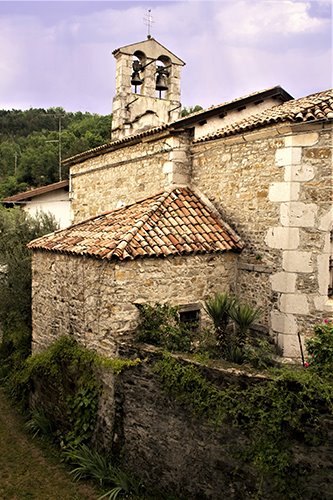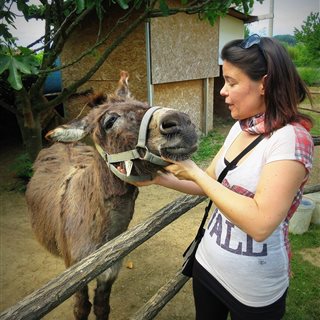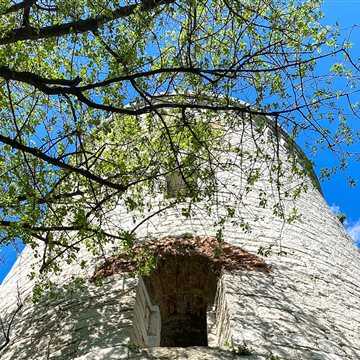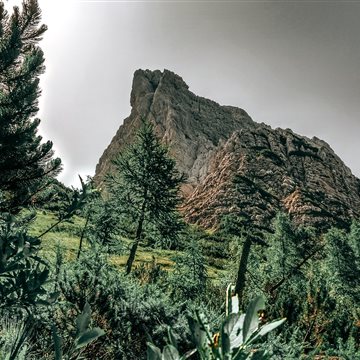



Are you a wine tourist? Then you will know that we are in the DOC area of ??the Colli Orientali del Friuli.
Are you cycling tourists? Then you will probably have followed the cycle paths that pass through this valley, the Valley of the Judrio.
But if you are hikers, then you absolutely must know that here, in the village of Prepotto, there are three international long-distance paths that pass across Friuli Venezia Giulia.
Their three symbols often appear together and they cannot fail to attract the attention of those who stroll through these lands with slow curiosity. They are: the Alpe Adria Trail (and specifically stage 29 that starts in Slovenia), the Cammino Celeste (here we are at the third stage that starts at Cormons) and the Via Alpina (here, the yellow B5 itinerary passes through, starting from Gorizia). All three have the same final destination for the day: the Sanctuary of Castelmonte, located in the municipality of Prepotto, on the border with San Leonardo, in the Natisone Valley.
For this reason alone, in my opinion, Prepotto and its hamlets deserves to be visited and explored. Due to its location and geographical position, close to borders that no longer exist, this place must have been an important meeting place in the past. History has been made here, with its people and its wars, but the vineyards here have remained, surviving all the events and today becoming a testimony to what once was the early environment that covered these hills, just as they were forming.

The three paths sometimes overlap and sometimes separate, offering the visitor the choice of which direction to take. There is one point in particular that I like very much. It is located in Centa di Prepotto, a pretty, small rural village collected around its attractive church and characterised by old stone houses dating back to the thirteenth century, today partly used as a B&B, and built in the past close to each other for protection and defence from enemy incursions. You will find an explanatory panel at the entrance to the village that explains the etymology of its name and, shortly after, indicated on a single wooden pole, the symbols of the three paths.
From here, a few steps more will bring you to a pretty little lane, where a homemade bench made with wooden beams seems to invite the hiker to sit down and enjoy the silence and scents of aromatic herbs all while deciding which way to go.
Once you get to the stone wall, there are two possibilities: you can follow the CAI no. 748 trail that turns right and leads uphill and so follow the Via Celeste/Alpina, visiting the frescoed votive chapels – some, like that of the three Kings, very isolated and immersed in the woods – walking through chestnut forests and broad meadows up to the Sanctuary of Castelmonte.
But I recommend you turn right on the Via Alpina for a bit towards the Castle of Albana. I came across this almost by accident and suddenly seeing it before me, as I came out of a woodland track was a great surprise. It was built in the middle of the country, in woods of oak, pine and hornbeam woods and you can only get to it along the path in the woods. It really deserves a closer look for at least two reasons:
- to have its history told to you. and to discover what was found during the renovation work. I have described the tale to the tourists I had the pleasure to accompany along the AAT (the castle can only be seen if you take a short detour from the official path and walk through the Schioppettino vineyards) and they enjoyed it very much.
- to observe and touch the splendid strata of “ponca” terrain (a show for my eyes) and observe how the geology of the rocky hill on which the castle stands is different to the terrain on which you were walking shortly before. There is plenty to say on this subject!
If you continue straight along the Alpe Adria Trail, after a pleasant stretch in the woods above the village of Centa, you arrive at the road in Brischis, where you will find a commemorative monument dedicated to the Italian cyclist Fausto Coppi. From here, you can choose whether to go along the upper valley of the Judrio, near the Slovenian border, and climb Monte Brischis if you so wish – this is the most highest hill of the area, where archaeological finds of ancient Neolithic settlements have been found – or whether to follow the forest paths that lead to the Colle Ternunich and enable you to go down to Prepotto, walking along the green "ronchi" or "roncs" in Friulian: the hills cultivated for vines.
The end of August and all of September are the ideal time to walk around here because all around you smells of grapes and the vintage, while in autumn the scent of must is replaced by the warm colours of the foliage. A spectacle for the eyes and for enthusiasts of nature photography.
Whatever path you take, remember that you are in the land of Schioppettino, a wine born and cultivated exclusively in this corner of the Colli Orientali and in no other part of our region. It is a true ambassador of these lands, the liquid expression of the history and traditions of this community and the perfect example of the close bond that unites wine with the nature, geography and local history of the hills where it is produced.
Its history is very interesting: it is an ancient native vine dating back to the thirteenth century, born in the little village of Cialla (sadly not visited by the three trails). Have yourself told the story of how it has been saved from extinction and why it is called Schioppettino: there are three versions. I tell my guests the most accredited version of the story which is associated with the feature of the grape skin. But have all three told to you, maybe while you sip a glass, because each is more curious than the last. If you do not like red wine, you can always opt for Schioppettino’s cousin (once called "Ribolla Nera”): Ribolla Gialla.
This is my personal elegy to the lands of Prepotto, where the vineyards are so perfectly integrated with the surrounding environment, as to allow you to combine hiking with an understanding of everything that is enclosed in a grape of a unique character.
As the Americans might say, who are experts in “wiking”:
“Make your stay at Prepotto an authentic and Active Wine Experience”.
Find out about the ideas and offers for this experience in Friuli Venezia Giulia




 Andrej Bandelj
Andrej Bandelj
